Features
LONDON-BERUWALA-AMBALANGODA-MATARA – Part 42
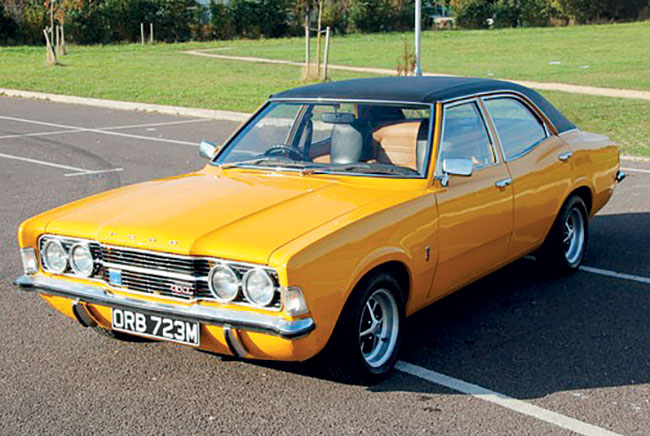
CONFESSIONS OF A GLOBAL GYPSY
By Dr. Chandana (Chandi) Jayawardena DPhil
President – Chandi J. Associates Inc. Consulting, Canada
Founder & Administrator – Global Hospitality Forum
chandij@sympatico.ca
Returning Home
My special Management Observer/Trainee program in London (UK) with then the largest hotel chain in the world – Trust House Forte (THF), ended on a high note in September 1979. Mr. Geoffrey Pye, Director of Personnel for THF London Hotels and Mr. Bejaramo, Catering Manager of the 900-room Cumberland Hotel conducted two exit interviews with me. They both were very pleased with my work, as well as with the observations I had made at the Cumberland and the Regent Palace Hotel where I was a Guest Observer.
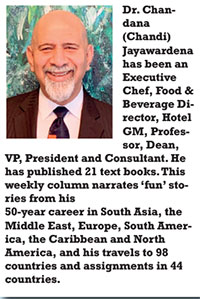
My associate from John Keells Group, Ranjith Dharmaratnam and I returned to Frankfurt to catch our charter flights arranged by Neckermann Reisen’s Kurt D. Wehner. I knew Kurt well having hosted him at the hotel I was managing – Hotel Swanee when he was touring Sri Lanka a few months ago. He reciprocated my hospitality in Frankfurt.
As a global traveller, my father had said to the family, “There is no place better than home”, every time he returned from a long, overseas trip. However, after returning from my first overseas trip to Thailand, West Germany and the United Kingdom, I did not share that view. “I feel that I can easily adapt myself to live anywhere in the world, and I would like to travel around the world and be a global gypsy”, I told my parents. “Well Chandana, it looks like you have been bitten by the travel bug. Here, look at this new publication by the largest airline in the world. Pan Am also owns the InterContinental hotel chain, where you had a part-time job a few years ago”, my father encouraged my new interest.
In the late 1970s most of the vehicles used in Sri Lanka were re-conditioned, old cars shipped from Europe and Japan. While in the UK, I bought my first car – a 1975 Ford Corolla with a vinyl top. It cost me only £350. After shipping it to Sri Lanka, I managed to get a very special licence number (11 SRI 1111). As I had the hotel manager’s car and a driver, I really did not need my own car. Therefore, I sold it to one of my uncles – M. D. Seneviratne, and made a good profit. My younger cousins thought that the car was cool and groovy!
Sharing my Learning
I was eager to apply some of the new management practices I learnt in London to the small operation I was heading in Sri Lanka. I quickly shared all relevant best practices I learnt in London and various materials I collected with my team. In settling back as a local hotelier, I introduced concepts such as longer orientations for new employees, printed training material, exit interviews for employees leaving and commenced pre-planning Christmas and New Year’s Eve celebrations with my team three months in advance. The usual practice in Sri Lankan hotels at that time was to begin planning the festive, seasonal events in December.
We commenced the 1979/1980 tourist season with a bang. We pre-planned a calendar of events for each month in consultation with tour leaders, returning guests and long stay guests. We recruited some very promising students of Ceylon Hotel School as our interns for the season. All of them, in a few years’ time, became highly successful hoteliers.
Before my overseas trip, I had attended a three-week long program “Techniques of Administration for Hotel Management” in Colombo, with 50 other Sri Lankan hotel managers. It was organized by the umbrella body for hotel industry in Sri Lanka – Ceylon Tourist Hotels Association. It was conducted by two professors (Hal Records and James Root) from the Cornell University, USA, which was famous for hotel administration programs. It was very similar to their well-known summer management program conducted in Ithaca, New York every year. Although academically, it was a good program, I learnt much more practical and implementable aspects of hotel management with THF in London.
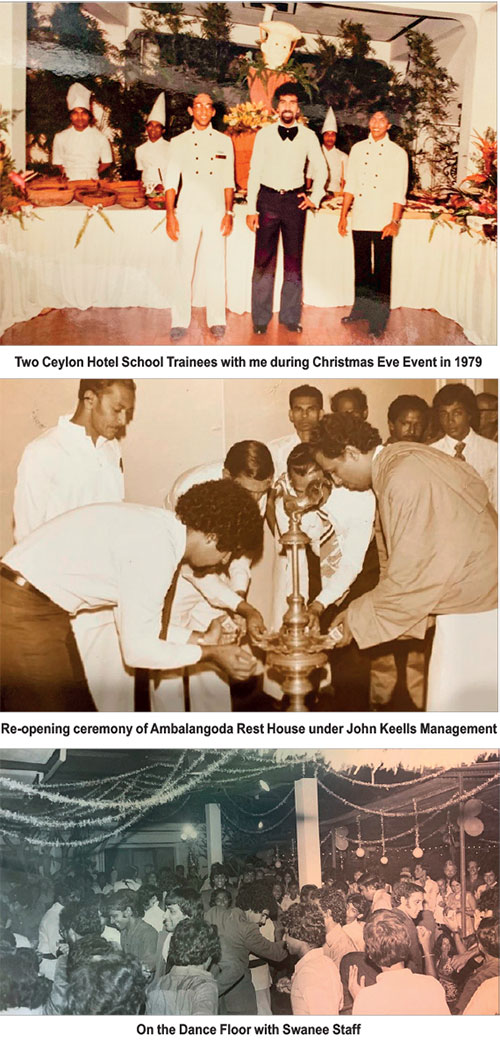
Overbooking with Ken Bala
It was the usual practice to overbook hotels by around 15% leaving room for cancellations. The new Managing Director of Walkers Tours, Mr. Ken Balendra (popularly referred as “Ken Bala”) asked me if I was in agreement. “Sure, let’s do it, but during the peak months, overbooking by 15% may be a challenge as the rate of cancellations usually went down from Christmas until the end of winter in Europe”, I cautioned him. Mr. Ken Balendra who was a very charismatic, energetic and optimistic person said, “Let’s go with the 15%.”
Hotel Swanee had only 52 bedrooms and by mid-December our occupancy went up to 115% with us requiring 60 rooms to accommodate tourists who were on their way from the airport. I quickly called Mr. Balendra. He was very busy, and said, “Chandana, you are our guy in Beruwala, and I trust that you will handle it well. All the best!” I immediately summoned my team to have a quick, stand-up brainstorming session. We had no time to waste and literally had to think on our feet. Our young team came with some “outlandish” suggestions and I promptly approved them and delegated the actions. In crisis management, the teams must think “outside the box”.
By the time the guests arrived at the hotel, we had moved most of the executives to the supervisory staff quarters. We also moved two of our executives to the executive quarters of neighbouring hotels to share rooms with their executives. Those hotels had not experienced overbooking challenges. Fortunately, we had excellent relationships with all of the competitor hotels in the area. Hotel Swanee executive rooms were converted to guest rooms within an hour but these rooms were smaller and below the usual standard of guest bedrooms. To avoid receiving complaints, we carefully chose those guests (friendly, repeat guests and younger couples) who were to be downgraded! We compensated them with complimentary fruit baskets, wine, chocolates, Christmas cake as well as free tickets to beach parties and lobster buffets.

During the Christmas week, the overbooking situation got worse. I released the Front Office Manager from his duties and sent him on a one-week island round trip with the excess guests, with complimentary excursions to well-known tourist sites around the island. Once again, we chose the guests for this option carefully. Tyrone Quin, our witty and creative Front Office Manager thoroughly enjoyed this adventure. “Boss, in my next career move, I would like to become a Tourist Guide, as I found it to be a lot of fun and lucrative!” Tyrone told me jokingly when he returned after one of those special trips.
Most Successful Tourist Season
Hotel Swanee New Year’s Eve dinner dance was a big success and it did not end until 6:00 am. In consultation with the European tour leaders, repeat guests, winners of “Swanee Best Guest/s weekly competitions” and long stay guests, we made an unprecedented decision to honour our hard-working employees. Around 12:45 am, after the guests had enjoyed their first dance session of the New Year with live music and in the midst of a fireworks display, we requested the guests to leave the dance floor.
We then invited all of the staff in their uniforms to come to the dance floor and dance with the managers and supervisors. We played some of their favourite songs chosen by the union. This act was an amazing success. Guests surrounded the dance floor and cheered the dancing employees, in full approval of our appreciation of the full team. Everybody loved it. Among other progressive gestures we had made to the employees over the months, this gesture was the icing on the cake.
Unlike many other hotels in Sri Lanka, we never had any union challenges at Hotel Swanee. Managers, supervisors and staff all worked in unison like one big, happy family. 1979/1980 was the most profitable tourist season of Hotel Swanee, since its opening in 1974.
In the middle of the tourist season, as previously planned, I married my fiancée. She was 19 and I was 26. My father-in-law and the former boss (then a corporate senior executive at John Keells Group), Captain D. A Wickramasinge and his wife Neetha planned a grand wedding with 600 guests at the Hotel Lanka Oberoi. It had many connections to John Keells Group, with the Chairman, Mr. Mark Bostock as the attesting witness, my boss, Bobby Adams (Director Operations – Hotels) as the best-man, a week’s honeymoon at the sister hotel – The Village and the homecoming event hosted at Hotel Swanee. My wife soon became an “unpaid” but important member of the Hotel Swanee team, particularly in the areas of guest relations and event hosting.
Manager of three Properties at age 26
By 1980, John Keells was expanding its hospitality business by acquiring some smaller properties with management contracts. Mainly owing to a personal relationship Bobby Adams had with then Prime Minister, R. Premadasa, the group commenced managing the Prime Minister’s official residence – Temple Trees. I released one of the departmental managers from Hotel Swanee – Fazal Izzadeen to become the Manager of Temple Trees. Fazal soon became so popular with the second family of Sri Lanka, he was hardly allowed by the second lady to go home for a weekend break.
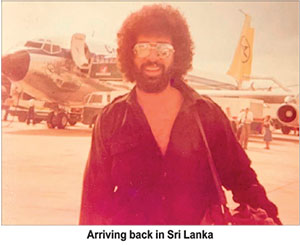
The group opened their second hotel in Beruwala, Hotel Bayroo, in the midst of various obstacles created by the village thugs. The group also commenced negotiating to take over the management of Hotel Ceylinco in Colombo. In addition to managing Hotel Swanee, I was asked to take over the Ambalangoda Rest House, to re-organize and improve its standards and to manage it.
I quickly learnt that managing a historic rest house with a deep, loyal following from the local population was a different ball game. Although there were tourists arriving for accommodations, the food and beverage operations depended mainly on the local clientele. One of our regular customers was, in my view, the most promising school Cricketer a decade ago – Anura “Century” Silva. When Anura captained Nalanda College and broke many records by scoring centuries in back-to-back games, I became his ardent fan. Anura was from a wealthy and well-connected family in Ambalangoda. My friendship with him prevented any trouble from the town.
This rest house on a small hill by the sea had a special charm. A natural, sea water pool and a long, front veranda added to the ambiance. I transferred some of our star supervisors and staff from Hotel Swanee to re-open the rest house. We focused on improving the style of management, maintenance, cleanliness, food quality and presentation and customer service. We introduced a Sunday lunch buffet with local specialties and many seafood dishes using the fresh catch from the local fishermen. This buffet became very popular with the locals.
When two leading lawyers from Colombo approached Bobby to convert one of their ancestral mansions to be a boutique hotel, I was given another additional assignment. It was a very nice and over a 100-year-old building on the Beach Road in Matara. As the house had only six bedrooms, John Keells was not interested. Therefore, Bobby and I got involved as Directors of the project with small investments. We opened it as the Beach Lodge in 1980. I continued to operate from Hotel Swanee but went to Ambalangoda and Matara once a week to oversee the operations of these two properties. Managing three small properties concurrently meant that I had to improve my delegative skills.
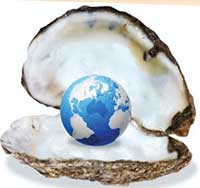
Bobby was impressed with my ability to multitask. He hinted that he may have to create a new post for me as his deputy at the John Keells corporate office to handle his growing portfolio. I showed interest in such a promotion. We agreed to consider it in the year 1981.
Features
The heart-friendly health minister

by Dr Gotabhya Ranasinghe
Senior Consultant Cardiologist
National Hospital Sri Lanka
When we sought a meeting with Hon Dr. Ramesh Pathirana, Minister of Health, he graciously cleared his busy schedule to accommodate us. Renowned for his attentive listening and deep understanding, Minister Pathirana is dedicated to advancing the health sector. His openness and transparency exemplify the qualities of an exemplary politician and minister.
Dr. Palitha Mahipala, the current Health Secretary, demonstrates both commendable enthusiasm and unwavering support. This combination of attributes makes him a highly compatible colleague for the esteemed Minister of Health.
Our discussion centered on a project that has been in the works for the past 30 years, one that no other minister had managed to advance.
Minister Pathirana, however, recognized the project’s significance and its potential to revolutionize care for heart patients.
The project involves the construction of a state-of-the-art facility at the premises of the National Hospital Colombo. The project’s location within the premises of the National Hospital underscores its importance and relevance to the healthcare infrastructure of the nation.
This facility will include a cardiology building and a tertiary care center, equipped with the latest technology to handle and treat all types of heart-related conditions and surgeries.
Securing funding was a major milestone for this initiative. Minister Pathirana successfully obtained approval for a $40 billion loan from the Asian Development Bank. With the funding in place, the foundation stone is scheduled to be laid in September this year, and construction will begin in January 2025.
This project guarantees a consistent and uninterrupted supply of stents and related medications for heart patients. As a result, patients will have timely access to essential medical supplies during their treatment and recovery. By securing these critical resources, the project aims to enhance patient outcomes, minimize treatment delays, and maintain the highest standards of cardiac care.
Upon its fruition, this monumental building will serve as a beacon of hope and healing, symbolizing the unwavering dedication to improving patient outcomes and fostering a healthier society.We anticipate a future marked by significant progress and positive outcomes in Sri Lanka’s cardiovascular treatment landscape within the foreseeable timeframe.
Features
A LOVING TRIBUTE TO JESUIT FR. ALOYSIUS PIERIS ON HIS 90th BIRTHDAY

by Fr. Emmanuel Fernando, OMI
Jesuit Fr. Aloysius Pieris (affectionately called Fr. Aloy) celebrated his 90th birthday on April 9, 2024 and I, as the editor of our Oblate Journal, THE MISSIONARY OBLATE had gone to press by that time. Immediately I decided to publish an article, appreciating the untiring selfless services he continues to offer for inter-Faith dialogue, the renewal of the Catholic Church, his concern for the poor and the suffering Sri Lankan masses and to me, the present writer.
It was in 1988, when I was appointed Director of the Oblate Scholastics at Ampitiya by the then Oblate Provincial Fr. Anselm Silva, that I came to know Fr. Aloy more closely. Knowing well his expertise in matters spiritual, theological, Indological and pastoral, and with the collaborative spirit of my companion-formators, our Oblate Scholastics were sent to Tulana, the Research and Encounter Centre, Kelaniya, of which he is the Founder-Director, for ‘exposure-programmes’ on matters spiritual, biblical, theological and pastoral. Some of these dimensions according to my view and that of my companion-formators, were not available at the National Seminary, Ampitiya.
Ever since that time, our Oblate formators/ accompaniers at the Oblate Scholasticate, Ampitiya , have continued to send our Oblate Scholastics to Tulana Centre for deepening their insights and convictions regarding matters needed to serve the people in today’s context. Fr. Aloy also had tried very enthusiastically with the Oblate team headed by Frs. Oswald Firth and Clement Waidyasekara to begin a Theologate, directed by the Religious Congregations in Sri Lanka, for the contextual formation/ accompaniment of their members. It should very well be a desired goal of the Leaders / Provincials of the Religious Congregations.
Besides being a formator/accompanier at the Oblate Scholasticate, I was entrusted also with the task of editing and publishing our Oblate journal, ‘The Missionary Oblate’. To maintain the quality of the journal I continue to depend on Fr. Aloy for his thought-provoking and stimulating articles on Biblical Spirituality, Biblical Theology and Ecclesiology. I am very grateful to him for his generous assistance. Of late, his writings on renewal of the Church, initiated by Pope St. John XX111 and continued by Pope Francis through the Synodal path, published in our Oblate journal, enable our readers to focus their attention also on the needed renewal in the Catholic Church in Sri Lanka. Fr. Aloy appreciated very much the Synodal path adopted by the Jesuit Pope Francis for the renewal of the Church, rooted very much on prayerful discernment. In my Religious and presbyteral life, Fr.Aloy continues to be my spiritual animator / guide and ongoing formator / acccompanier.
Fr. Aloysius Pieris, BA Hons (Lond), LPh (SHC, India), STL (PFT, Naples), PhD (SLU/VC), ThD (Tilburg), D.Ltt (KU), has been one of the eminent Asian theologians well recognized internationally and one who has lectured and held visiting chairs in many universities both in the West and in the East. Many members of Religious Congregations from Asian countries have benefited from his lectures and guidance in the East Asian Pastoral Institute (EAPI) in Manila, Philippines. He had been a Theologian consulted by the Federation of Asian Bishops’ Conferences for many years. During his professorship at the Gregorian University in Rome, he was called to be a member of a special group of advisers on other religions consulted by Pope Paul VI.
Fr. Aloy is the author of more than 30 books and well over 500 Research Papers. Some of his books and articles have been translated and published in several countries. Among those books, one can find the following: 1) The Genesis of an Asian Theology of Liberation (An Autobiographical Excursus on the Art of Theologising in Asia, 2) An Asian Theology of Liberation, 3) Providential Timeliness of Vatican 11 (a long-overdue halt to a scandalous millennium, 4) Give Vatican 11 a chance, 5) Leadership in the Church, 6) Relishing our faith in working for justice (Themes for study and discussion), 7) A Message meant mainly, not exclusively for Jesuits (Background information necessary for helping Francis renew the Church), 8) Lent in Lanka (Reflections and Resolutions, 9) Love meets wisdom (A Christian Experience of Buddhism, 10) Fire and Water 11) God’s Reign for God’s poor, 12) Our Unhiddden Agenda (How we Jesuits work, pray and form our men). He is also the Editor of two journals, Vagdevi, Journal of Religious Reflection and Dialogue, New Series.
Fr. Aloy has a BA in Pali and Sanskrit from the University of London and a Ph.D in Buddhist Philosophy from the University of Sri Lankan, Vidyodaya Campus. On Nov. 23, 2019, he was awarded the prestigious honorary Doctorate of Literature (D.Litt) by the Chancellor of the University of Kelaniya, the Most Venerable Welamitiyawe Dharmakirthi Sri Kusala Dhamma Thera.
Fr. Aloy continues to be a promoter of Gospel values and virtues. Justice as a constitutive dimension of love and social concern for the downtrodden masses are very much noted in his life and work. He had very much appreciated the commitment of the late Fr. Joseph (Joe) Fernando, the National Director of the Social and Economic Centre (SEDEC) for the poor.
In Sri Lanka, a few religious Congregations – the Good Shepherd Sisters, the Christian Brothers, the Marist Brothers and the Oblates – have invited him to animate their members especially during their Provincial Congresses, Chapters and International Conferences. The mainline Christian Churches also have sought his advice and followed his seminars. I, for one, regret very much, that the Sri Lankan authorities of the Catholic Church –today’s Hierarchy—- have not sought Fr.
Aloy’s expertise for the renewal of the Catholic Church in Sri Lanka and thus have not benefited from the immense store of wisdom and insight that he can offer to our local Church while the Sri Lankan bishops who governed the Catholic church in the immediate aftermath of the Second Vatican Council (Edmund Fernando OMI, Anthony de Saram, Leo Nanayakkara OSB, Frank Marcus Fernando, Paul Perera,) visited him and consulted him on many matters. Among the Tamil Bishops, Bishop Rayappu Joseph was keeping close contact with him and Bishop J. Deogupillai hosted him and his team visiting him after the horrible Black July massacre of Tamils.
Features
A fairy tale, success or debacle

Sri Lanka-Singapore Free Trade Agreement
By Gomi Senadhira
senadhiragomi@gmail.com
“You might tell fairy tales, but the progress of a country cannot be achieved through such narratives. A country cannot be developed by making false promises. The country moved backward because of the electoral promises made by political parties throughout time. We have witnessed that the ultimate result of this is the country becoming bankrupt. Unfortunately, many segments of the population have not come to realize this yet.” – President Ranil Wickremesinghe, 2024 Budget speech
Any Sri Lankan would agree with the above words of President Wickremesinghe on the false promises our politicians and officials make and the fairy tales they narrate which bankrupted this country. So, to understand this, let’s look at one such fairy tale with lots of false promises; Ranil Wickremesinghe’s greatest achievement in the area of international trade and investment promotion during the Yahapalana period, Sri Lanka-Singapore Free Trade Agreement (SLSFTA).
It is appropriate and timely to do it now as Finance Minister Wickremesinghe has just presented to parliament a bill on the National Policy on Economic Transformation which includes the establishment of an Office for International Trade and the Sri Lanka Institute of Economics and International Trade.
Was SLSFTA a “Cleverly negotiated Free Trade Agreement” as stated by the (former) Minister of Development Strategies and International Trade Malik Samarawickrama during the Parliamentary Debate on the SLSFTA in July 2018, or a colossal blunder covered up with lies, false promises, and fairy tales? After SLSFTA was signed there were a number of fairy tales published on this agreement by the Ministry of Development Strategies and International, Institute of Policy Studies, and others.
However, for this article, I would like to limit my comments to the speech by Minister Samarawickrama during the Parliamentary Debate, and the two most important areas in the agreement which were covered up with lies, fairy tales, and false promises, namely: revenue loss for Sri Lanka and Investment from Singapore. On the other important area, “Waste products dumping” I do not want to comment here as I have written extensively on the issue.
1. The revenue loss
During the Parliamentary Debate in July 2018, Minister Samarawickrama stated “…. let me reiterate that this FTA with Singapore has been very cleverly negotiated by us…. The liberalisation programme under this FTA has been carefully designed to have the least impact on domestic industry and revenue collection. We have included all revenue sensitive items in the negative list of items which will not be subject to removal of tariff. Therefore, 97.8% revenue from Customs duty is protected. Our tariff liberalisation will take place over a period of 12-15 years! In fact, the revenue earned through tariffs on goods imported from Singapore last year was Rs. 35 billion.
The revenue loss for over the next 15 years due to the FTA is only Rs. 733 million– which when annualised, on average, is just Rs. 51 million. That is just 0.14% per year! So anyone who claims the Singapore FTA causes revenue loss to the Government cannot do basic arithmetic! Mr. Speaker, in conclusion, I call on my fellow members of this House – don’t mislead the public with baseless criticism that is not grounded in facts. Don’t look at petty politics and use these issues for your own political survival.”
I was surprised to read the minister’s speech because an article published in January 2018 in “The Straits Times“, based on information released by the Singaporean Negotiators stated, “…. With the FTA, tariff savings for Singapore exports are estimated to hit $10 million annually“.
As the annual tariff savings (that is the revenue loss for Sri Lanka) calculated by the Singaporean Negotiators, Singaporean $ 10 million (Sri Lankan rupees 1,200 million in 2018) was way above the rupees’ 733 million revenue loss for 15 years estimated by the Sri Lankan negotiators, it was clear to any observer that one of the parties to the agreement had not done the basic arithmetic!
Six years later, according to a report published by “The Morning” newspaper, speaking at the Committee on Public Finance (COPF) on 7th May 2024, Mr Samarawickrama’s chief trade negotiator K.J. Weerasinghehad had admitted “…. that forecasted revenue loss for the Government of Sri Lanka through the Singapore FTA is Rs. 450 million in 2023 and Rs. 1.3 billion in 2024.”
If these numbers are correct, as tariff liberalisation under the SLSFTA has just started, we will pass Rs 2 billion very soon. Then, the question is how Sri Lanka’s trade negotiators made such a colossal blunder. Didn’t they do their basic arithmetic? If they didn’t know how to do basic arithmetic they should have at least done their basic readings. For example, the headline of the article published in The Straits Times in January 2018 was “Singapore, Sri Lanka sign FTA, annual savings of $10m expected”.
Anyway, as Sri Lanka’s chief negotiator reiterated at the COPF meeting that “…. since 99% of the tariffs in Singapore have zero rates of duty, Sri Lanka has agreed on 80% tariff liberalisation over a period of 15 years while expecting Singapore investments to address the imbalance in trade,” let’s turn towards investment.
Investment from Singapore
In July 2018, speaking during the Parliamentary Debate on the FTA this is what Minister Malik Samarawickrama stated on investment from Singapore, “Already, thanks to this FTA, in just the past two-and-a-half months since the agreement came into effect we have received a proposal from Singapore for investment amounting to $ 14.8 billion in an oil refinery for export of petroleum products. In addition, we have proposals for a steel manufacturing plant for exports ($ 1 billion investment), flour milling plant ($ 50 million), sugar refinery ($ 200 million). This adds up to more than $ 16.05 billion in the pipeline on these projects alone.
And all of these projects will create thousands of more jobs for our people. In principle approval has already been granted by the BOI and the investors are awaiting the release of land the environmental approvals to commence the project.
I request the Opposition and those with vested interests to change their narrow-minded thinking and join us to develop our country. We must always look at what is best for the whole community, not just the few who may oppose. We owe it to our people to courageously take decisions that will change their lives for the better.”
According to the media report I quoted earlier, speaking at the Committee on Public Finance (COPF) Chief Negotiator Weerasinghe has admitted that Sri Lanka was not happy with overall Singapore investments that have come in the past few years in return for the trade liberalisation under the Singapore-Sri Lanka Free Trade Agreement. He has added that between 2021 and 2023 the total investment from Singapore had been around $162 million!
What happened to those projects worth $16 billion negotiated, thanks to the SLSFTA, in just the two-and-a-half months after the agreement came into effect and approved by the BOI? I do not know about the steel manufacturing plant for exports ($ 1 billion investment), flour milling plant ($ 50 million) and sugar refinery ($ 200 million).
However, story of the multibillion-dollar investment in the Petroleum Refinery unfolded in a manner that would qualify it as the best fairy tale with false promises presented by our politicians and the officials, prior to 2019 elections.
Though many Sri Lankans got to know, through the media which repeatedly highlighted a plethora of issues surrounding the project and the questionable credentials of the Singaporean investor, the construction work on the Mirrijiwela Oil Refinery along with the cement factory began on the24th of March 2019 with a bang and Minister Ranil Wickremesinghe and his ministers along with the foreign and local dignitaries laid the foundation stones.
That was few months before the 2019 Presidential elections. Inaugurating the construction work Prime Minister Ranil Wickremesinghe said the projects will create thousands of job opportunities in the area and surrounding districts.
The oil refinery, which was to be built over 200 acres of land, with the capacity to refine 200,000 barrels of crude oil per day, was to generate US$7 billion of exports and create 1,500 direct and 3,000 indirect jobs. The construction of the refinery was to be completed in 44 months. Four years later, in August 2023 the Cabinet of Ministers approved the proposal presented by President Ranil Wickremesinghe to cancel the agreement with the investors of the refinery as the project has not been implemented! Can they explain to the country how much money was wasted to produce that fairy tale?
It is obvious that the President, ministers, and officials had made huge blunders and had deliberately misled the public and the parliament on the revenue loss and potential investment from SLSFTA with fairy tales and false promises.
As the president himself said, a country cannot be developed by making false promises or with fairy tales and these false promises and fairy tales had bankrupted the country. “Unfortunately, many segments of the population have not come to realize this yet”.
(The writer, a specialist and an activist on trade and development issues . )












